Discover the supply chain visibility importance for your business. Learn how seeing your freight reduces risks, boosts efficiency, and delights customers.
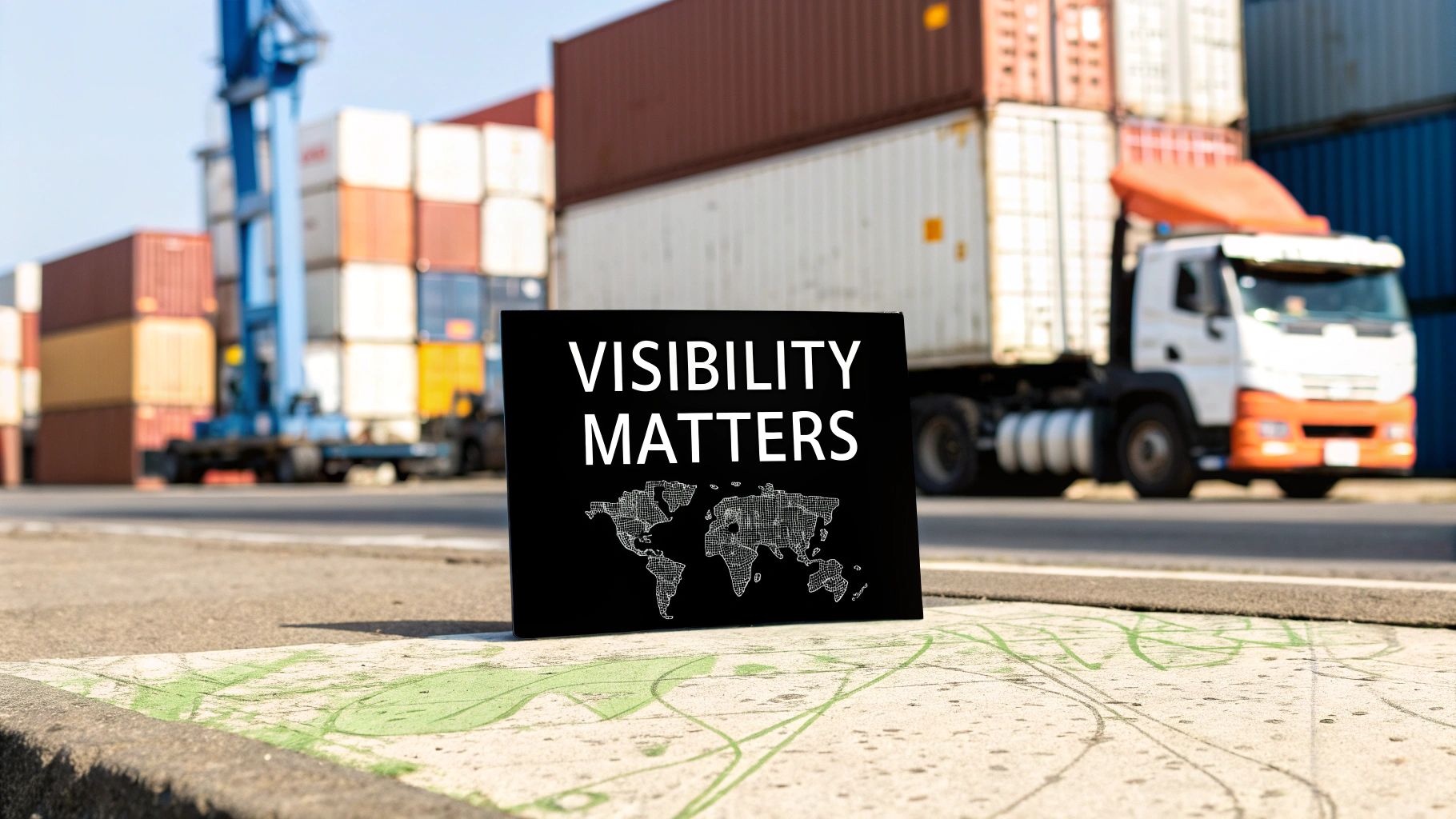
The importance of supply chain visibility boils down to a simple, timeless truth: you can't manage what you can't see. In today's market, having real-time, end-to-end knowledge of your products' journey isn't just a leg up on the competition—it's a fundamental requirement for survival. It directly shapes your efficiency, your exposure to risk, and, most importantly, your customer's happiness.
Let’s cut through the buzzwords. Think about ordering a pizza. You get an alert when it goes in the oven, when it leaves the store, and you can even track the driver on a map right to your door. That’s visibility.
Now, apply that same idea to your most critical freight shipments. Supply chain visibility is the ability to see your products at every step of their journey—from the moment they leave a raw material supplier, through the manufacturing floor, into distribution centers, and all the way to your customer's doorstep.
In a world full of disruptions, operating without this clear view is more than just a minor blind spot; it’s a massive operational risk. This is why the conversation around supply chain visibility has shifted from a "nice-to-have" feature to a core business necessity. It’s about finally ditching the clunky spreadsheets and endless "where's my shipment?" phone calls for modern, connected platforms that put you back in control.
As you can see, visibility isn't a single benefit but a powerful foundation for a stronger, more resilient operation.
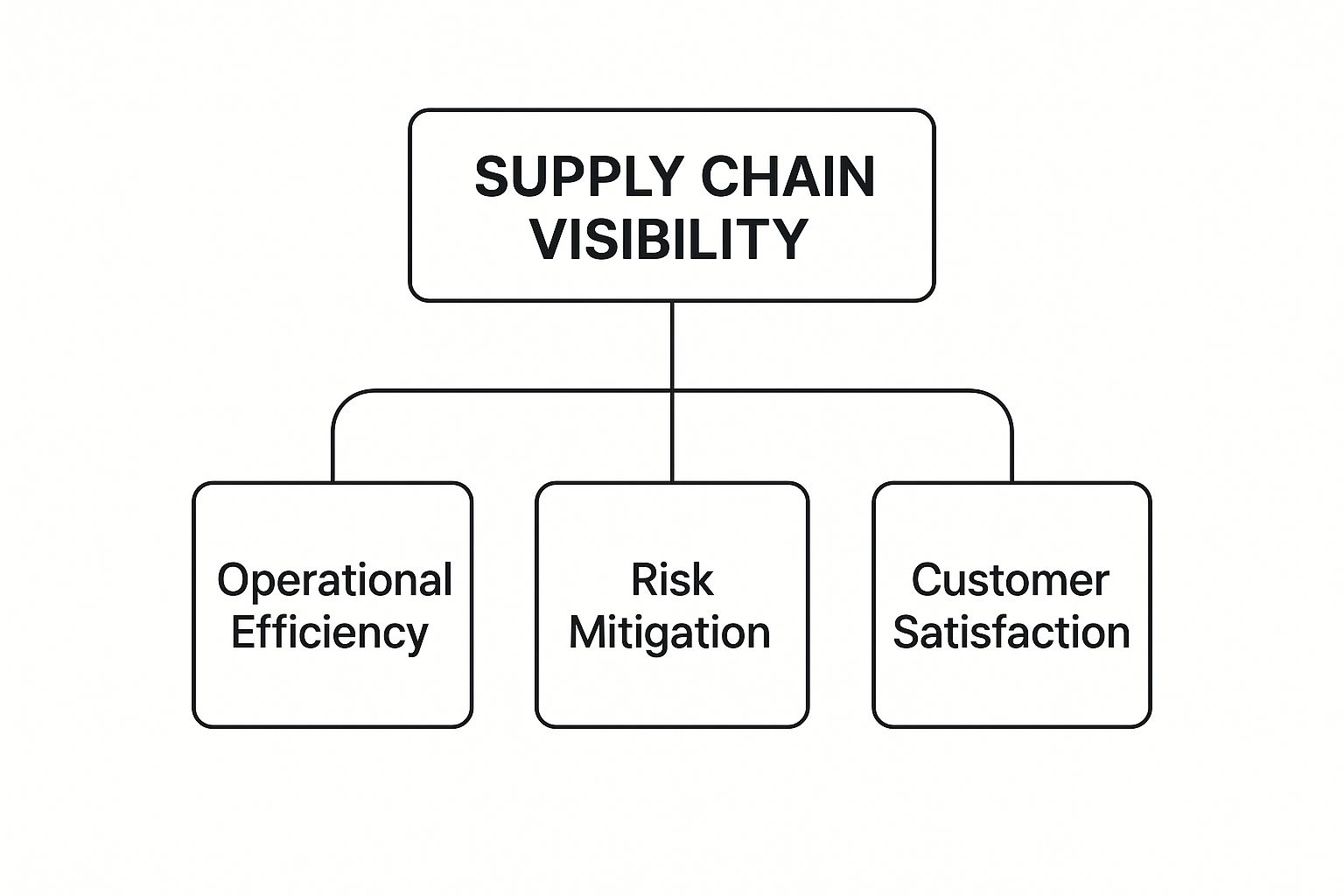
This simple breakdown shows how achieving genuine visibility directly leads to better efficiency, smarter risk management, and a customer experience that builds loyalty.
The consequences of poor visibility have snowballed beyond simple delays. It's a sobering reality, but recent research shows that a staggering 76% of manufacturers admit their supply chain visibility is limited. A few years ago, that gap might have just meant a missed deadline.
Today, it can trigger far more severe outcomes, including serious reputational damage, fines for non-compliance, and financial losses that can run into the millions.
This new reality makes a cohesive visibility strategy non-negotiable. Getting a handle on the basics is the first step toward building a more transparent and predictable operation. For a deeper dive into these foundational concepts, our guide on supply chain management fundamentals is a great place to start.
It's time to stop guessing and start knowing. The old way of managing logistics—reacting to problems as they happen—just doesn't cut it anymore. Moving from manual processes to a unified platform is the key to unlocking true visibility.
A truly visible supply chain provides the data you need to make proactive, intelligent decisions instead of constantly putting out fires. It transforms your logistics from a frustrating cost center into a strategic asset that actually drives growth.
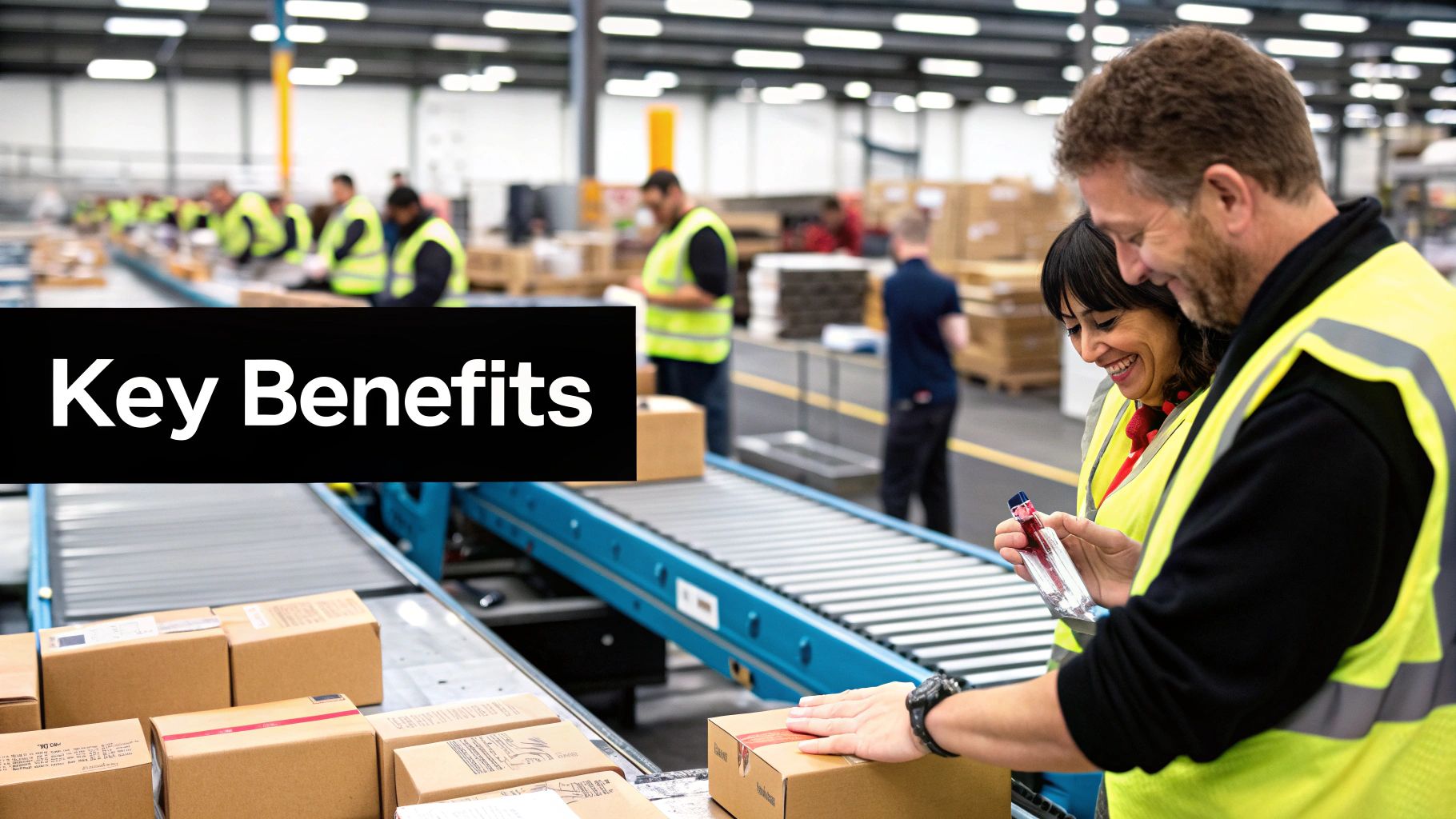
It’s one thing to talk about supply chain visibility in theory, but what does it actually do for your business? The real magic happens when you turn that data into smarter, faster, and more cost-effective decisions on the ground.
When you can see every moving part, you stop constantly reacting to problems and start getting ahead of them. This shift from reactive to proactive is where you’ll find a serious competitive edge.
One of the first places you’ll see an impact is your bottom line. Those little inefficiencies—wasted time, extra fuel, and idle labor—add up fast when you’re operating with blind spots.
Think about detention fees, those frustrating charges carriers tack on when a truck is stuck at a loading dock for too long. With clear visibility, you know exactly when a truck will arrive, so your team can be ready to unload it immediately. No more preventable costs.
It’s the same with your FTL and LTL freight routes. Real-time data on traffic and weather lets you adjust on the fly, saving fuel and shortening transit times.
By giving businesses a clear, real-time picture of their supply chain, visibility empowers them to prevent bottlenecks, reduce waste, and keep processes running at peak efficiency. This isn't just about saving money—it's about building a leaner, more resilient operation from the ground up.
Today's supply chains are fragile. A port delay, a labor strike, or a sudden storm can throw a wrench into everything. Without visibility, each of these is a potential disaster just waiting to unfold.
Let’s say a critical LTL freight shipment is en route to a port that suddenly closes. If you’re in the dark, you might not find out for hours—or even days. By then, your shipment is buried in a massive backlog.
But with real-time tracking, you get an instant alert. You can immediately reroute the truck to a different port, coordinate with your carrier, and give your customer a revised—but still reliable—delivery date. What could have been a costly, brand-damaging mess becomes a minor logistical tweak.
At the end of the day, all of this leads to one thing: a better experience for your customers. In this market, giving people accurate ETAs and proactive updates isn't just a nice-to-have; it's what they expect.
When a customer can see exactly where their order is, their trust in your brand skyrockets. This transparency also slashes the number of "Where is my order?" calls, freeing up your customer service team to focus on more important things.
Happier customers mean repeat business and great reviews, creating a flywheel for growth. And it all starts with giving them a clear, honest answer to their most important question.
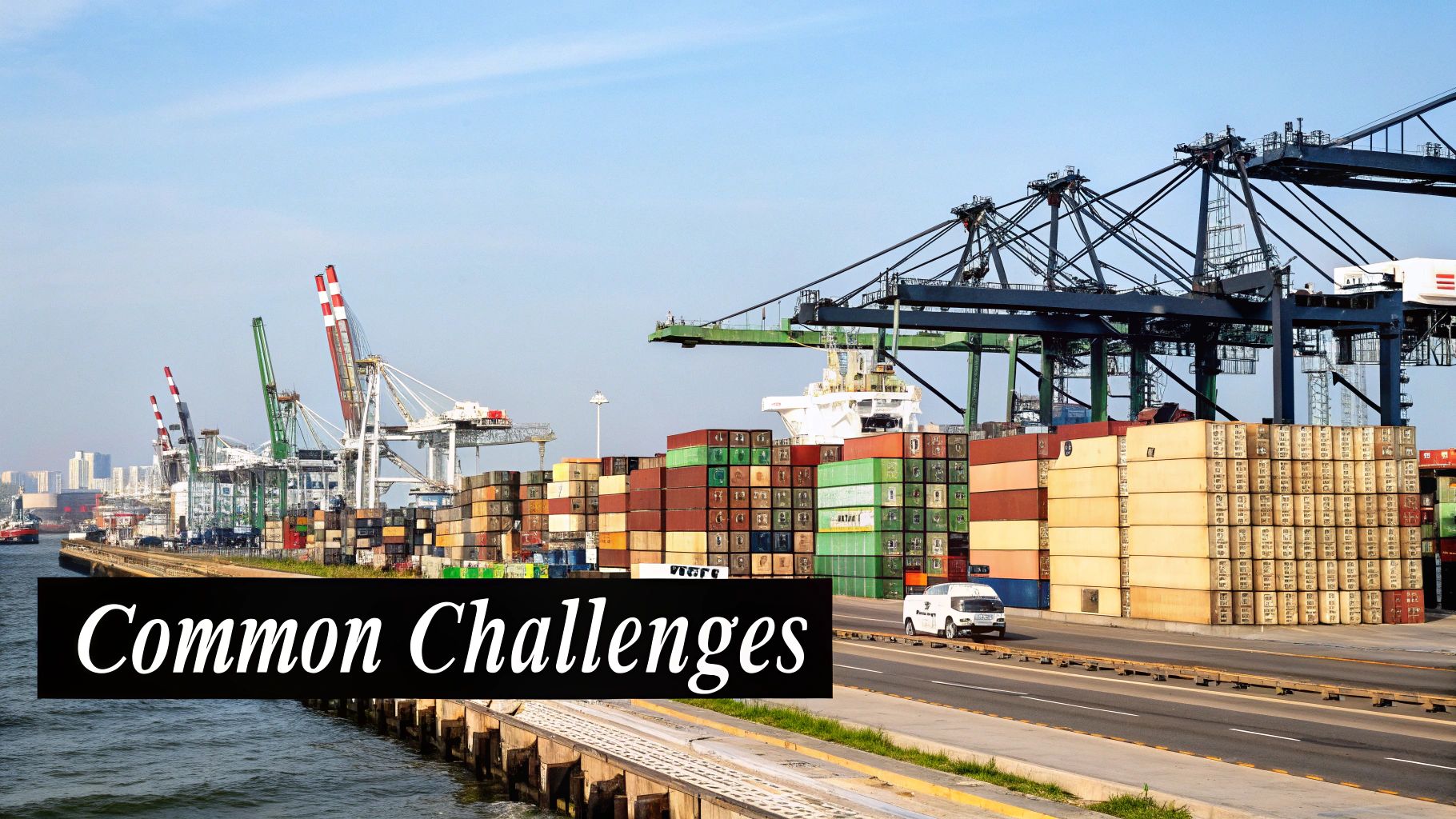
With all the clear wins that come from supply chain visibility, you'd think every company would have a crystal-clear view of their operations. But the truth is, a surprising number of businesses are still trying to navigate their supply chains with a blindfold on. The gap between wanting transparency and actually having it is massive.
This isn't for a lack of trying. The real problem is a tangled web of challenges that feed into each other. So many companies are still wrestling with outdated, legacy systems that just don't talk to one another. Important information gets locked away in different departmental "silos"—the warehouse has its system, accounting has another, and freight is managed across a dozen different spreadsheets.
This fractured approach makes getting a single, cohesive picture of the supply chain next to impossible. What you end up with is a confusing patchwork of old, often conflicting data.
When your systems aren't talking, neither are your teams. A warehouse manager might be looking at one set of inventory numbers, while the sales team is making promises based on a completely different set. This kind of misalignment causes all sorts of headaches, from accidental stockouts to promising customers delivery dates that are physically impossible to meet.
The real issue here is the lack of a "single source of truth." If you can't trust your data, every decision becomes a guess instead of a calculated move. It's a surprisingly common struggle, and it's one that directly hamstrings your ability to manage both FTL and LTL shipments effectively.
The tough reality is that most companies are just getting started on the road to real transparency. This isn't just a minor operational pain; it's a huge strategic weakness. It leaves a business wide open to disruptions that a more connected competitor could sidestep without breaking a sweat.
Are your LTL shipments really moving as efficiently as they could be? Without a unified view, how can you be sure?
This visibility gap tends to get bigger the deeper you look into your network. A business might have a pretty good handle on its direct suppliers, but things get fuzzy fast when you start talking about their suppliers' suppliers.
This creates all sorts of hidden risks. A raw material shortage at a tier-three supplier—someone you've probably never even heard of—can grind your entire production line to a halt. And you won't see it coming until it's far too late.
Recent data shows just how big this blind spot is. As of mid-2025, only a tiny 13% of companies said they had full, end-to-end visibility that stretched all the way back to raw material sourcing. And while 54% can now identify over half their suppliers, the slow progress shows how exposed most businesses still are. You can dig deeper into these supply chain visibility trends and findings for more context.
Once you start recognizing these common industry struggles, you can begin to see where your own weak points are—and why making supply chain visibility a top priority is so incredibly urgent.
Knowing you have a visibility gap is one thing, but actually closing it takes a solid game plan. The real work begins when you start to untangle the messy data, disconnected partners, and outdated systems that keep you in the dark. This is where the true value of supply chain visibility becomes crystal clear—turning operational chaos into confident control.
The push for better visibility isn't just coming from inside the company. External pressures, from sudden geopolitical storms to customers demanding more sustainable sourcing, have made transparency a must-have, not a nice-to-have. And these aren't just abstract ideas; they hit your bottom line. In fact, 56% of companies said that trade conflicts and other geopolitical issues directly messed with their supply chains in 2023. You can see more on these key supply chain statistics and their impact.
You can't just flip a switch and get perfect visibility. It's about taking deliberate, targeted steps to fix the most common problems.
The goal is to move from constantly putting out fires to a place where you can see potential disruptions coming and act before they happen. This shift is what separates a fragile operation from a truly durable one.
This proactive mindset is the foundation of a strong logistics network. For a deeper dive, check out our guide on building effective supply chain resilience strategies to help you prepare for whatever comes next.
At the end of the day, conquering your visibility challenges is all about using technology to make better, faster decisions. Tools like AI and predictive analytics aren't just buzzwords anymore; they’re essential for making sense of the mountains of data a supply chain produces.
These systems can spot patterns, flag a potential delay before it even happens, and even suggest a new route for your freight. That's how you turn a small hiccup into a non-issue. By integrating your systems, working with your partners, and choosing the right tools, you can break down the walls that block your view. Your supply chain stops being a source of stress and becomes one of your biggest competitive strengths.
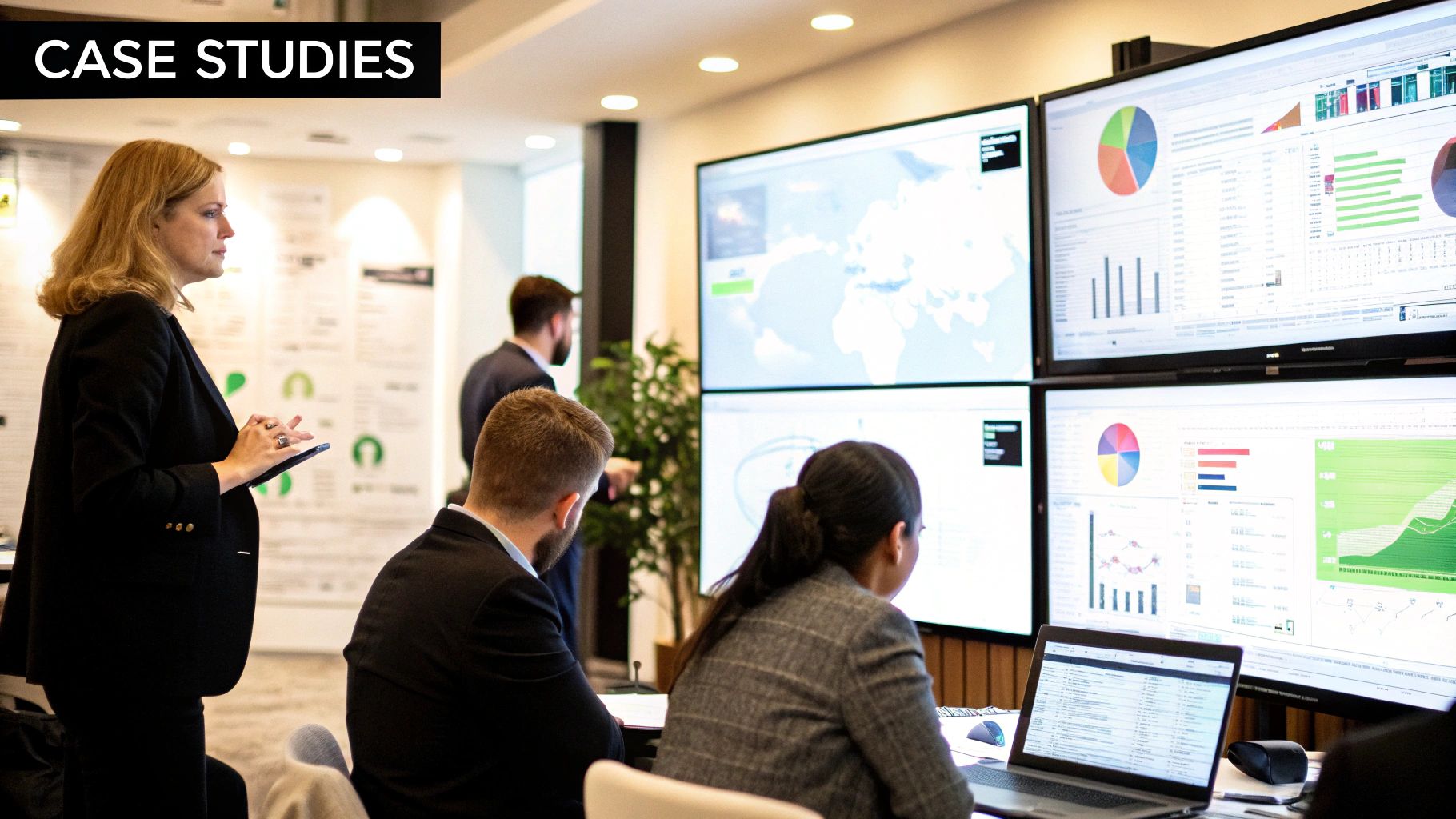
So, how does all this visibility actually work? It’s not magic. True supply chain transparency comes from smart technology weaving together a flood of messy data into something you can actually use.
Think of a modern visibility platform as the central command center for your entire logistics network. It becomes your single source of truth by pulling in information from dozens of different, disconnected places and organizing it into one clean, unified view.
This central hub connects all the critical pieces of your supply chain puzzle. It doesn't just track one thing; it brings everything together to create a complete, real-time picture of what’s happening.
A good platform pulls from all the places you'd expect:
By pooling all this information, the platform turns raw, chaotic data into simple dashboards, real-time alerts, and predictive ETAs that are actually accurate. It’s a core reason why supply chain visibility importance has shot up for businesses trying to stay competitive.
Let’s walk through a single LTL shipment to see how this all comes together.
Imagine you’re shipping a pallet from a warehouse in Chicago to a customer in Atlanta. The old way, you might get an update when it’s picked up and another when it (hopefully) gets delivered. Everything that happens in between? A total black box.
With a modern platform, you see every single step. You get an alert the moment the truck pulls away from the dock. You see it arrive at a cross-docking facility in Nashville. If a storm pops up outside Chattanooga and causes a delay, you get a proactive notification with a new, updated ETA.
This level of detail ensures everyone—from the warehouse manager to the sales team to the end customer—is perfectly in sync. It eliminates the guesswork, the anxious phone calls, and the confusion that comes from operating in the dark.
This transparency is also a huge piece of planning ahead. Having a clear view of your entire network is a cornerstone of effective supply chain risk management because it lets you spot potential hiccups before they turn into expensive disasters. It’s all about building a supply chain that isn't just efficient, but also genuinely resilient.
Getting a truly clear view of your supply chain doesn’t happen overnight. Think of it less like flipping a switch and more like a journey. It’s all about taking deliberate, practical steps to shift from constantly putting out fires to being in a proactive, controlled position. After all, the real power of supply chain visibility isn't just about collecting data—it's about using that data to build a resilient, efficient, and customer-focused operation.
The whole process kicks off with a simple question: where are the blind spots? You can't fix what you can't see, so the first move is always a brutally honest look at where you stand right now.
Before you can draw a map to your destination, you need to know your starting point. A quick audit is the perfect way to pinpoint your biggest gaps and find the low-hanging fruit—the opportunities that will give you the most bang for your buck.
Start by asking your team a few critical questions:
Answering these honestly will shine a bright light on the exact weak points that are draining your time and money.
The objective isn't to achieve perfection on day one. The goal is to start with high-impact, manageable steps that deliver immediate value, like gaining real-time control over your LTL and FTL freight shipments.
Once you've identified your weaknesses, it's time to build a step-by-step plan. Let’s be real: trying to fix everything at once is a classic recipe for disaster. The smarter move is to focus on a phased rollout.
This methodical approach builds momentum. Each step adds real, tangible value, giving you the confidence and the tools you need to build a supply chain that's far more predictable and efficient.
It's totally normal to have a few questions, even with a solid plan in hand. Let's tackle some of the most common ones that come up when we talk about supply chain visibility.
This is a great question, and it's easy to mix these two up. Think of it like this:
Supply chain visibility is your live, bird's-eye view. It’s about knowing where your shipment is right now and what its status is. It’s like watching your FTL freight move across a map in real-time.
Traceability, on the other hand, is like being a detective. It’s about digging into the past to see the entire history of a specific product or part. This is absolutely critical for things like quality control, managing recalls, or proving compliance.
You don't need a massive budget to make a real difference. For small businesses, the key is to start with small, smart steps that have a big impact.
A great first move is to stop juggling scattered emails and phone calls. Try to bring all communication with your main carriers into one central place.
Even better, start using a freight service that gives you free, built-in tracking for LTL shipments. This simple step gives you instant insight into a huge part of your logistics without needing to invest in expensive, complex technology upfront.
Figuring out the return on your investment comes down to tracking a few key numbers. Once you know what to look for, the financial upside becomes obvious pretty quickly.
A strong ROI case is built on tangible improvements. Look for direct cost reductions in areas like detention fees, penalties for missed delivery windows, and the amount of "safety stock" inventory you must hold to cover potential delays.
Beyond that, look at the "soft" savings. How much less time is your team spending on the phone chasing down tracking updates or answering "Where is my order?" calls? And, most importantly, keep an eye on your on-time delivery rate. When that number goes up, customer satisfaction and repeat business almost always follow.